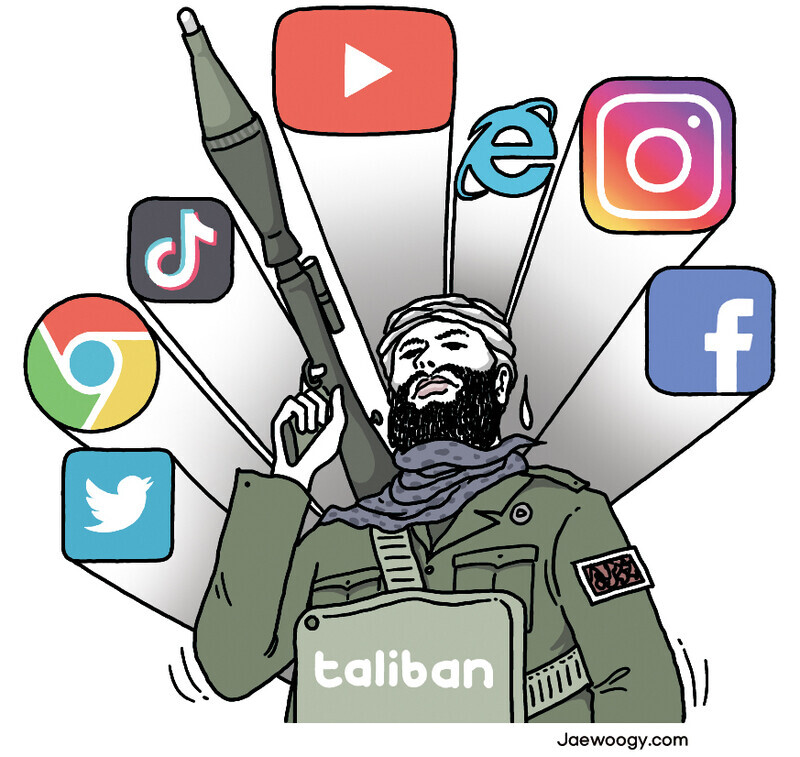hankyoreh
Links to other country sites 다른 나라 사이트 링크
[Column] Taliban’s latest enemy is internet

A photograph of the Taliban command occupying the president’s office in the Presidential Palace in Kabul sent the message that the group had regained control over Afghanistan after 20 years. The photograph, posted on Aug. 15, showed members armed with rifles, along with others filming the events by smartphone.
Back in 2001, the Taliban were considered symbols of a backlash against “civilization,” with their demolition of the Buddhas of Bamiyan, a UNESCO World Heritage, and their bans on education of and activities by women. Now they have returned as active users of the latest information technology.
Twenty years ago, the Taliban banned the internet. Now they are sending messages out by smartphones and social media to demand the world’s acknowledgment.
Zabihullah Mujahid, the Taliban’s spokesperson and channel for external communication, counts over 340,000 Twitter followers. Each day, he posts dozens of messages and videos sharing the Taliban’s new policies.
Since its creation in April 2017, his Twitter account has racked up over 29,000 messages. In five different languages — including Pashto, Dari, and English — the Taliban have been emphasizing a ban on political retaliation and a return to everyday life.
US social media businesses have each adopted different standards for allowing the Taliban to operate accounts. Facebook, YouTube, and WhatsApp all barred the Taliban from making an account, while Twitter allowed it. This stands in sharp contrast to its permanent suspension of former US President Donald Trump’s account for reasons including incitement to violence.
After the US military spent an astronomical amount of money and military resources over the past 20 years, the Taliban finally succeeded in driving them out. But the Taliban have a real hurdle to clear before they are able to establish a stable administration: a battle with the internet.
Afghanistan today is different from 20 years ago. According to the market research firm Statista, the number of mobile phone users in Afghanistan exploded from one million in 2005 to 22 million as of 2019.
The Taliban would need advanced technology and a specialized workforce to either prohibit internet use by Afghans or censor content at the state level the way China and Pakistan do. James A. Lewis, senior vice president of the Center for Strategic and International Studies, predicted that the Taliban would adopt Pakistan as a role model.
Ten years ago, the Arab Spring took off like a wildfire, only to burn itself out. It made a mockery of any rash predictions about the relationship between social media and democracy.
A new experiment has begun, where the survival of the Taliban depends on how far they can use the power of religion and force to suppress and tame a public that has now gotten a taste of the internet and social media.
By Koo Bon-kwon, senior staff writer
Please direct comments or questions to [english@hani.co.kr]

Editorial・opinion
![[Editorial] Intensifying US-China rivalry means Seoul must address uncertainty with Beijing sooner than later [Editorial] Intensifying US-China rivalry means Seoul must address uncertainty with Beijing sooner than later](https://flexible.img.hani.co.kr/flexible/normal/500/300/imgdb/original/2024/0517/8117159322045222.jpg) [Editorial] Intensifying US-China rivalry means Seoul must address uncertainty with Beijing sooner than later
[Editorial] Intensifying US-China rivalry means Seoul must address uncertainty with Beijing sooner than later![[Column] When ‘fairness’ means hate and violence [Column] When ‘fairness’ means hate and violence](https://flexible.img.hani.co.kr/flexible/normal/500/300/imgdb/original/2024/0516/7417158465908824.jpg) [Column] When ‘fairness’ means hate and violence
[Column] When ‘fairness’ means hate and violence- [Editorial] Yoon must stop abusing authority to shield himself from investigation
- [Column] US troop withdrawal from Korea could be the Acheson Line all over
- [Column] How to win back readers who’ve turned to YouTube for news
- [Column] Welcome to the president’s pity party
- [Editorial] Korea must respond firmly to Japan’s attempt to usurp Line
- [Editorial] Transfers of prosecutors investigating Korea’s first lady send chilling message
- [Column] Will Seoul’s ties with Moscow really recover on their own?
- [Column] Samsung’s ‘lost decade’ and Lee Jae-yong’s mismatched chopsticks
Most viewed articles
- 1For new generation of Chinese artists, discontent is disobedience
- 2[Column] US troop withdrawal from Korea could be the Acheson Line all over
- 3[Editorial] Intensifying US-China rivalry means Seoul must address uncertainty with Beijing sooner t
- 4[Exclusive] Unearthed memo suggests Gwangju Uprising missing may have been cremated
- 5China calls US tariffs ‘madness,’ warns of full-on trade conflict
- 6[Editorial] Transfers of prosecutors investigating Korea’s first lady send chilling message
- 7Xi, Putin ‘oppose acts of military intimidation’ against N. Korea by US in joint statement
- 8[Column] When ‘fairness’ means hate and violence
- 9Another chaebol heir caught smuggling liquid marijuana into South Korea
- 10For Korea’s Justice Ministry, no place is sacred from immigration raids